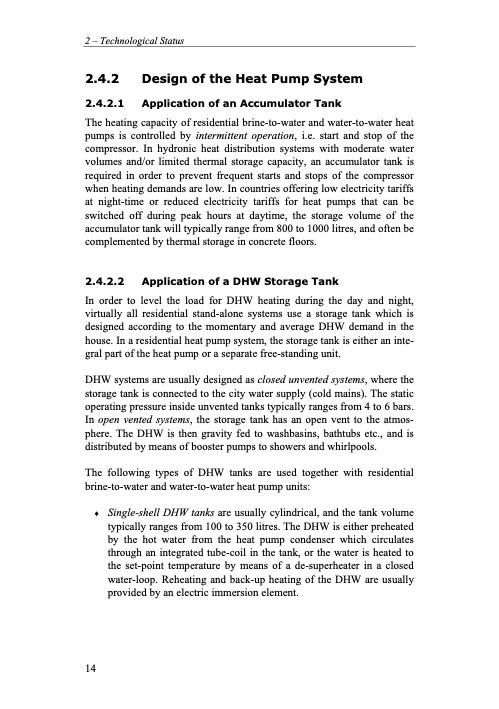
PDF Publication Title:
Text from PDF Page: 036
2 – Technological Status 2.4.2 Design of the Heat Pump System 2.4.2.1 Application of an Accumulator Tank The heating capacity of residential brine-to-water and water-to-water heat pumps is controlled by intermittent operation, i.e. start and stop of the compressor. In hydronic heat distribution systems with moderate water volumes and/or limited thermal storage capacity, an accumulator tank is required in order to prevent frequent starts and stops of the compressor when heating demands are low. In countries offering low electricity tariffs at night-time or reduced electricity tariffs for heat pumps that can be switched off during peak hours at daytime, the storage volume of the accumulator tank will typically range from 800 to 1000 litres, and often be complemented by thermal storage in concrete floors. 2.4.2.2 Application of a DHW Storage Tank In order to level the load for DHW heating during the day and night, virtually all residential stand-alone systems use a storage tank which is designed according to the momentary and average DHW demand in the house. In a residential heat pump system, the storage tank is either an inte- gral part of the heat pump or a separate free-standing unit. DHW systems are usually designed as closed unvented systems, where the storage tank is connected to the city water supply (cold mains). The static operating pressure inside unvented tanks typically ranges from 4 to 6 bars. In open vented systems, the storage tank has an open vent to the atmos- phere. The DHW is then gravity fed to washbasins, bathtubs etc., and is distributed by means of booster pumps to showers and whirlpools. The following types of DHW tanks are used together with residential brine-to-water and water-to-water heat pump units: ♦ Single-shell DHW tanks are usually cylindrical, and the tank volume typically ranges from 100 to 350 litres. The DHW is either preheated by the hot water from the heat pump condenser which circulates through an integrated tube-coil in the tank, or the water is heated to the set-point temperature by means of a de-superheater in a closed water-loop. Reheating and back-up heating of the DHW are usually provided by an electric immersion element. 14PDF Image | Residential CO2 Heat Pump System for Combined

PDF Search Title:
Residential CO2 Heat Pump System for CombinedOriginal File Name Searched:
20559406.pdfDIY PDF Search: Google It | Yahoo | Bing
CO2 Organic Rankine Cycle Experimenter Platform The supercritical CO2 phase change system is both a heat pump and organic rankine cycle which can be used for those purposes and as a supercritical extractor for advanced subcritical and supercritical extraction technology. Uses include producing nanoparticles, precious metal CO2 extraction, lithium battery recycling, and other applications... More Info
Heat Pumps CO2 ORC Heat Pump System Platform More Info
| CONTACT TEL: 608-238-6001 Email: greg@infinityturbine.com | RSS | AMP |